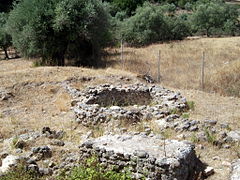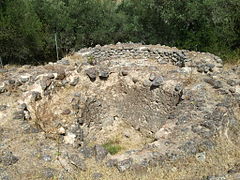Monte da Tumba
Monte da Tumba is a Copper Age fortified settlement on the outskirts of Torrão in Portugal . According to 14C data, the settlement of Monte da Tumba towards the end of the 4th but certainly at the beginning of the 3rd millennium BC. Started. In 1982, during the construction of a building, the walls of a complex were noticed that were the cause of archaeological excavations between 1982 and 1986. An area of about 750 m² was exposed; the scattering of finds takes up an area of altogether 2500 m².
It is a complex with towers and bastions that form three irregular, more or less concentric walls. The walls are built using two-shell technology in a stone-earth bond. The sequence of layers up to 2.5 m deep in some places made it possible to distinguish between three main phases with sub-phases of settlement. The more precise structure was possible through the overlapping of walls as well as extensions and conversions.
Settlement phases
Phase Ia
Some storage pits, which are no longer visible today, and sparse remains of a fortification wall are evidence of the first settlement. The environment probably consisted of a more or less dense forest of mainly holm oaks (Carvalho) and pine trees in which aurochs, deer, wild horses and wild boars lived, whose bones were found.
- Monte da Tumba
Phase Ib
The second, approximately 1.2 to 1.5 m thick wall ring is erected over layer Ia, the height of which in some places still reaches 1.9 m. This more or less oval wall ring was later provided with relatively large semicircular bastions in the northwest and southeast. In addition, numerous thin layers remained from this phase, which could be recognized as floors. The end of phase Ib is defined by the destruction of large parts of the 2nd fortification line. In the stratigraphy one recognized thick clay packets, which the excavators suggest to the effect that the rising masonry was made of clay. In contrast to phase Ia, domestic animals (pigs, sheep, goats and cattle) predominate among the animal bones.
Phase II
New walls are being built on the mud collapses from phase Ib. The third, the outer line will be shifted a little to the south and expanded with smaller bastions than in the previous phase. Overall, the walls are thinner than in phase I. A round house was discovered in the southwest, which was outside the 3rd line of defense but was connected to it by a wall. It has a small entrance on the east. In the opinion of the excavators, a clay dome arched over its relatively thick, tower-like foundations, which had apparently collapsed in a fire and buried a settlement horizon under it. The entire inventory of the house was found there in situ , between complete ceramic vessels and a flat copper hatchet, shards of cast cones with copper drops still stuck to them. Presumably copper was being processed in this house, which may have caused the fire. The animal bone finds from phase II show a predominance of domestic animals, mainly pigs were kept.
Phase III
Phase III is separated from Phase II by thick fall layers, but because it is close to the surface, it is poorly preserved. The central tower with a diameter of 12 m dates from this time. Phase III dates, as some bell shards show, from the younger Copper Age. Wild animals, especially deer, are on the rise again among animal bones.
literature
- António Rafael Carvalho: Torrão do Alentejo: Arqueologia, História e Património . Vol. 1. Alcácer do Sal 2009, O Monte da Tumba, p. 41–44 ( full text as digitized version [PDF; 6.0 MB ]).
- Thomas G. Schattner (Hrsg.): Archaeological guide through Portugal (= cultural history of the ancient world . Volume 74 ). Philipp von Zabern, Mainz 1998, ISBN 3-8053-2313-1 , p. 178-179 .
Web links
Coordinates: 38 ° 17 ′ 1 ″ N , 8 ° 13 ′ 52 ″ W.



